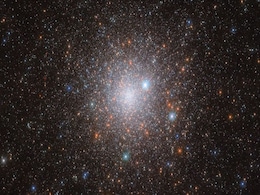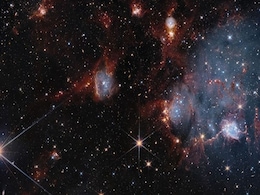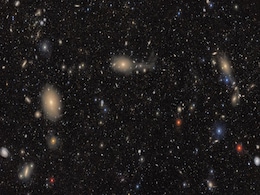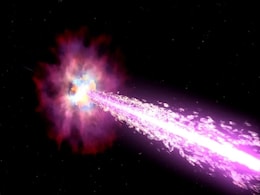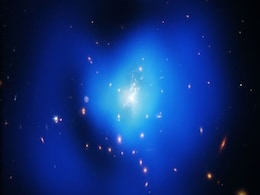Cluster Universities
- All
- News
-

NASA Finds Most Distant Calm Galaxy Cluster Ever Seen in Early Universe
- Friday January 2, 2026
- Written by Gadgets 360 Staff
Astronomers using NASA’s Chandra X-ray Observatory have discovered SPT-CL J2215-3537, a massive galaxy cluster located 8.4 billion light-years away. Nicknamed the “Champagne Supernova” cluster, it is the most distant relaxed cluster ever observed, showing no signs of recent collisions. Its calm structure and active star formation challenge ex...
-
 www.gadgets360.com
www.gadgets360.com
-

NASA’s Chandra Spots Champagne Cluster Formed by a Massive Galaxy Collision
- Wednesday December 31, 2025
- Written by Gadgets 360 Staff
Discovered on New Year’s Eve 2020, the Champagne Cluster is a striking pair of colliding galaxy clusters revealed through combined X-ray and optical observations. NASA’s Chandra X-ray Observatory shows superheated gas stretched and distorted, exposing a massive cosmic collision hidden from visible light alone. Studied by UC Davis astronomers, t...
-
 www.gadgets360.com
www.gadgets360.com
-

Chandra’s New X-Ray Mapping Exposes the Invisible Engines Powering Galaxy Clusters
- Friday December 12, 2025
- Written by Gadgets 360 Staff
NASA’s Chandra X-ray Observatory has released stunning colour-coded galaxy cluster images that reveal shock waves, cooling gas, and cavities carved by supermassive black holes. By separating X-ray light into different energy bands, astronomers can now visualise hidden cosmic processes that shape the universe’s largest structures and control how...
-
 www.gadgets360.com
www.gadgets360.com
-

Chandra’s New X-Ray Mapping Exposes the Invisible Engines Powering Galaxy Clusters
- Friday December 12, 2025
- Written by Gadgets 360 Staff
NASA’s Chandra X-ray Observatory has released stunning colour-coded galaxy cluster images that reveal shock waves, cooling gas, and cavities carved by supermassive black holes. By separating X-ray light into different energy bands, astronomers can now visualise hidden cosmic processes that shape the universe’s largest structures and control how...
-
 www.gadgets360.com
www.gadgets360.com
-

Study Reveals The Mystery Behind Giant Radio Relics In The Universe
- Monday November 24, 2025
- Science | Edited by Astitva Raj
Based on these initial findings, the team further developed extremely high-resolution simulations called "shock-tubes."
-
 www.ndtv.com
www.ndtv.com
-

James Webb Telescope May Have Spotted First Generation of Stars in the Universe
- Sunday November 16, 2025
- Written by Gadgets 360 Staff
Astronomers using JWST may have discovered Population III stars in cluster LAP1-B, offering new insights into early galaxy formation and the universe’s first luminous objects. JWST observations suggest Population III stars may have formed 13 billion years ago, helping trace early galaxies. These stars might be building blocks for larger galaxies ...
-
 www.gadgets360.com
www.gadgets360.com
-

Hubble Unveils Dark Matter Web in Stunning Abell 209 Galaxy Cluster Image
- Sunday July 20, 2025
- Written by Gadgets 360 Staff
NASA/ESA’s Hubble Space Telescope has released a stunning new image of Abell 209, a massive galaxy cluster 2.8 billion light-years away in Cetus. The golden cluster houses over 100 galaxies, but beneath them lies an invisible web of hot gas and dark matter. Using gravitational lensing, Hubble reveals curved arcs of light from background galaxies,...
-
 www.gadgets360.com
www.gadgets360.com
-

NASA’s Hubble and Webb Discover Bursting Star Formation in Small Magellanic Cloud
- Saturday July 12, 2025
- Written by Gadgets 360 Staff
NASA’s Hubble and Webb telescopes have captured spectacular images of NGC 460 and NGC 456, two star clusters in the Small Magellanic Cloud. These young, open clusters are filled with massive, hot stars that trigger new star formation by carving nebulae. The findings provide insights into early universe conditions and interstellar medium behaviour...
-
 www.gadgets360.com
www.gadgets360.com
-

Webb Telescope Spots Possible Jellyfish Galaxy 12 Billion Light-Years Away
- Thursday July 3, 2025
- Written by Gadgets 360 Staff
Astronomers using the James Webb Space Telescope have identified a possible jellyfish galaxy about 12 billion light-years away. Named COSMOS2020-635829, it shows tentacle-like streams of gas and stars trailing off one side—likely formed through ram pressure stripping in a dense cluster. If confirmed, it would be the most distant jellyfish galaxy ...
-
 www.gadgets360.com
www.gadgets360.com
-

Most Distant Mini-Halo Discovered in Galaxy Cluster 10 Billion Light-Years Away
- Monday June 30, 2025
- Written by Gadgets 360 Staff
Astronomers have uncovered the most distant mini-halo ever detected, located around the galaxy cluster SpARCS1049, a staggering 10 billion light-years from Earth. Using the LOFAR radio telescope network, which spans eight European countries, researchers detected a faint, diffuse glow—evidence of a giant cloud of high-energy particles and magnetic...
-
 www.gadgets360.com
www.gadgets360.com
-

Vera C. Rubin Observatory Unveils First Images, Hints at Universe’s Dynamic Secrets Ahead
- Wednesday June 25, 2025
- Written by Gadgets 360 Staff
The Rubin Observatory’s first image captures 10 million galaxies, marking the start of a decade-long sky survey. With its powerful telescope and LSST camera, it will scan the southern sky every three nights, unveiling hidden galaxies, stellar nurseries, and transient cosmic events. Scientists anticipate transformative discoveries about dark matte...
-
 www.gadgets360.com
www.gadgets360.com
-

Two Galaxy Clusters That Collided Previously Are All Set To Smash Again
- Saturday June 7, 2025
- Science | Edited by Abhinav Singh
Despite their enormous distance, the galaxy clusters are gravitationally bound and slowly turning back for another high-speed impact.
-
 www.ndtv.com
www.ndtv.com
-

New Study Finds Hercules-Corona Borealis Great Wall Bigger and Nearer Than Thought
- Wednesday April 23, 2025
- Written by Gadgets 360 Staff
GRBs uncover a more massive and closer Hercules–Corona Borealis Great Wall, reshaping cosmic scale theories.Astronomers have found that the Hercules–Corona Borealis Great Wall—the largest known structure in the universe—is even larger and closer than previously thought. Spanning 10 billion light-years, this immense cluster of galaxies was t...
-
 www.gadgets360.com
www.gadgets360.com
-

Hubble Captures Stunning Infrared Image of Sh2-284, a Massive Stellar Nursery
- Wednesday March 12, 2025
- Written by Gadgets 360 Staff
Hubble’s latest image of the massive Sh2-284 nebula reveals young stars concealed within thick clouds of gas and dust. Using infrared imaging, astronomers have captured details previously obscured in optical wavelengths. The nebula’s low-metallicity composition provides a glimpse into the conditions of the early universe, shedding light on how ...
-
 www.gadgets360.com
www.gadgets360.com
-

JWST Identifies Cooling Gas in Phoenix Cluster, Unlocking Star Formation Process
- Thursday February 20, 2025
- Written by Gadgets 360 Staff
The James Webb Space Telescope has detected the missing cooling gas in the Phoenix Cluster, a galaxy cluster located 5.8 billion light-years away. Researchers used the Mid-Infrared Instrument (MIRI) to identify gas at around 540,000 degrees Fahrenheit trapped in cavities within the cluster. This discovery resolves a long-standing mystery of how sta...
-
 www.gadgets360.com
www.gadgets360.com
-

NASA Finds Most Distant Calm Galaxy Cluster Ever Seen in Early Universe
- Friday January 2, 2026
- Written by Gadgets 360 Staff
Astronomers using NASA’s Chandra X-ray Observatory have discovered SPT-CL J2215-3537, a massive galaxy cluster located 8.4 billion light-years away. Nicknamed the “Champagne Supernova” cluster, it is the most distant relaxed cluster ever observed, showing no signs of recent collisions. Its calm structure and active star formation challenge ex...
-
 www.gadgets360.com
www.gadgets360.com
-

NASA’s Chandra Spots Champagne Cluster Formed by a Massive Galaxy Collision
- Wednesday December 31, 2025
- Written by Gadgets 360 Staff
Discovered on New Year’s Eve 2020, the Champagne Cluster is a striking pair of colliding galaxy clusters revealed through combined X-ray and optical observations. NASA’s Chandra X-ray Observatory shows superheated gas stretched and distorted, exposing a massive cosmic collision hidden from visible light alone. Studied by UC Davis astronomers, t...
-
 www.gadgets360.com
www.gadgets360.com
-

Chandra’s New X-Ray Mapping Exposes the Invisible Engines Powering Galaxy Clusters
- Friday December 12, 2025
- Written by Gadgets 360 Staff
NASA’s Chandra X-ray Observatory has released stunning colour-coded galaxy cluster images that reveal shock waves, cooling gas, and cavities carved by supermassive black holes. By separating X-ray light into different energy bands, astronomers can now visualise hidden cosmic processes that shape the universe’s largest structures and control how...
-
 www.gadgets360.com
www.gadgets360.com
-

Chandra’s New X-Ray Mapping Exposes the Invisible Engines Powering Galaxy Clusters
- Friday December 12, 2025
- Written by Gadgets 360 Staff
NASA’s Chandra X-ray Observatory has released stunning colour-coded galaxy cluster images that reveal shock waves, cooling gas, and cavities carved by supermassive black holes. By separating X-ray light into different energy bands, astronomers can now visualise hidden cosmic processes that shape the universe’s largest structures and control how...
-
 www.gadgets360.com
www.gadgets360.com
-

Study Reveals The Mystery Behind Giant Radio Relics In The Universe
- Monday November 24, 2025
- Science | Edited by Astitva Raj
Based on these initial findings, the team further developed extremely high-resolution simulations called "shock-tubes."
-
 www.ndtv.com
www.ndtv.com
-

James Webb Telescope May Have Spotted First Generation of Stars in the Universe
- Sunday November 16, 2025
- Written by Gadgets 360 Staff
Astronomers using JWST may have discovered Population III stars in cluster LAP1-B, offering new insights into early galaxy formation and the universe’s first luminous objects. JWST observations suggest Population III stars may have formed 13 billion years ago, helping trace early galaxies. These stars might be building blocks for larger galaxies ...
-
 www.gadgets360.com
www.gadgets360.com
-

Hubble Unveils Dark Matter Web in Stunning Abell 209 Galaxy Cluster Image
- Sunday July 20, 2025
- Written by Gadgets 360 Staff
NASA/ESA’s Hubble Space Telescope has released a stunning new image of Abell 209, a massive galaxy cluster 2.8 billion light-years away in Cetus. The golden cluster houses over 100 galaxies, but beneath them lies an invisible web of hot gas and dark matter. Using gravitational lensing, Hubble reveals curved arcs of light from background galaxies,...
-
 www.gadgets360.com
www.gadgets360.com
-

NASA’s Hubble and Webb Discover Bursting Star Formation in Small Magellanic Cloud
- Saturday July 12, 2025
- Written by Gadgets 360 Staff
NASA’s Hubble and Webb telescopes have captured spectacular images of NGC 460 and NGC 456, two star clusters in the Small Magellanic Cloud. These young, open clusters are filled with massive, hot stars that trigger new star formation by carving nebulae. The findings provide insights into early universe conditions and interstellar medium behaviour...
-
 www.gadgets360.com
www.gadgets360.com
-

Webb Telescope Spots Possible Jellyfish Galaxy 12 Billion Light-Years Away
- Thursday July 3, 2025
- Written by Gadgets 360 Staff
Astronomers using the James Webb Space Telescope have identified a possible jellyfish galaxy about 12 billion light-years away. Named COSMOS2020-635829, it shows tentacle-like streams of gas and stars trailing off one side—likely formed through ram pressure stripping in a dense cluster. If confirmed, it would be the most distant jellyfish galaxy ...
-
 www.gadgets360.com
www.gadgets360.com
-

Most Distant Mini-Halo Discovered in Galaxy Cluster 10 Billion Light-Years Away
- Monday June 30, 2025
- Written by Gadgets 360 Staff
Astronomers have uncovered the most distant mini-halo ever detected, located around the galaxy cluster SpARCS1049, a staggering 10 billion light-years from Earth. Using the LOFAR radio telescope network, which spans eight European countries, researchers detected a faint, diffuse glow—evidence of a giant cloud of high-energy particles and magnetic...
-
 www.gadgets360.com
www.gadgets360.com
-

Vera C. Rubin Observatory Unveils First Images, Hints at Universe’s Dynamic Secrets Ahead
- Wednesday June 25, 2025
- Written by Gadgets 360 Staff
The Rubin Observatory’s first image captures 10 million galaxies, marking the start of a decade-long sky survey. With its powerful telescope and LSST camera, it will scan the southern sky every three nights, unveiling hidden galaxies, stellar nurseries, and transient cosmic events. Scientists anticipate transformative discoveries about dark matte...
-
 www.gadgets360.com
www.gadgets360.com
-

Two Galaxy Clusters That Collided Previously Are All Set To Smash Again
- Saturday June 7, 2025
- Science | Edited by Abhinav Singh
Despite their enormous distance, the galaxy clusters are gravitationally bound and slowly turning back for another high-speed impact.
-
 www.ndtv.com
www.ndtv.com
-

New Study Finds Hercules-Corona Borealis Great Wall Bigger and Nearer Than Thought
- Wednesday April 23, 2025
- Written by Gadgets 360 Staff
GRBs uncover a more massive and closer Hercules–Corona Borealis Great Wall, reshaping cosmic scale theories.Astronomers have found that the Hercules–Corona Borealis Great Wall—the largest known structure in the universe—is even larger and closer than previously thought. Spanning 10 billion light-years, this immense cluster of galaxies was t...
-
 www.gadgets360.com
www.gadgets360.com
-

Hubble Captures Stunning Infrared Image of Sh2-284, a Massive Stellar Nursery
- Wednesday March 12, 2025
- Written by Gadgets 360 Staff
Hubble’s latest image of the massive Sh2-284 nebula reveals young stars concealed within thick clouds of gas and dust. Using infrared imaging, astronomers have captured details previously obscured in optical wavelengths. The nebula’s low-metallicity composition provides a glimpse into the conditions of the early universe, shedding light on how ...
-
 www.gadgets360.com
www.gadgets360.com
-

JWST Identifies Cooling Gas in Phoenix Cluster, Unlocking Star Formation Process
- Thursday February 20, 2025
- Written by Gadgets 360 Staff
The James Webb Space Telescope has detected the missing cooling gas in the Phoenix Cluster, a galaxy cluster located 5.8 billion light-years away. Researchers used the Mid-Infrared Instrument (MIRI) to identify gas at around 540,000 degrees Fahrenheit trapped in cavities within the cluster. This discovery resolves a long-standing mystery of how sta...
-
 www.gadgets360.com
www.gadgets360.com







